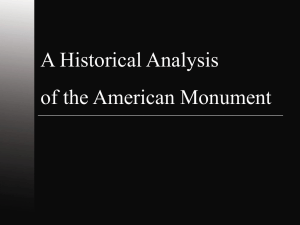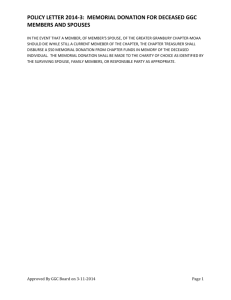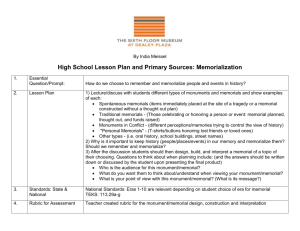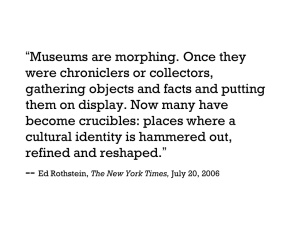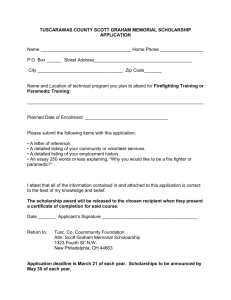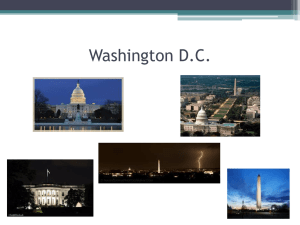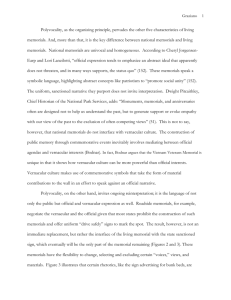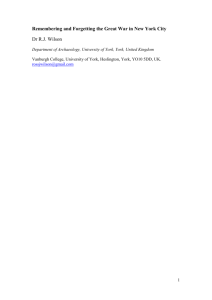Week 8 (October 27): The Holocaust in American Memory
advertisement
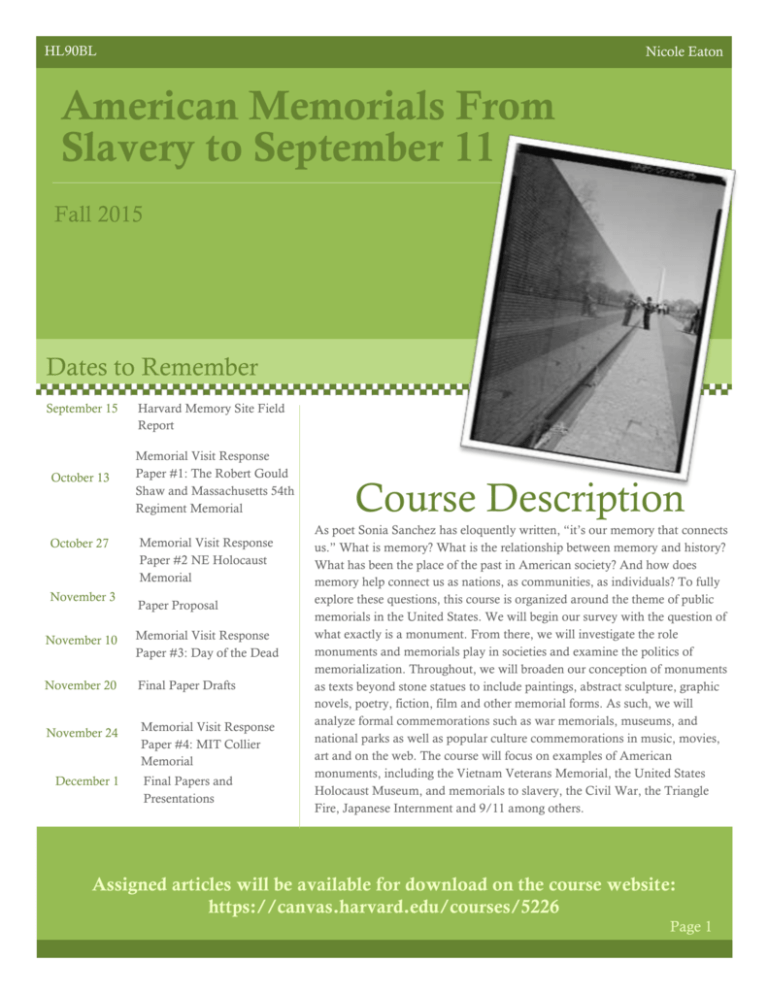
HL90BL Nicole Eaton American Memorials From Slavery to September 11 Fall 2015 Dates to Remember September 15 October 13 October 27 November 3 Harvard Memory Site Field Report Memorial Visit Response Paper #1: The Robert Gould Shaw and Massachusetts 54th Regiment Memorial Memorial Visit Response Paper #2 NE Holocaust Memorial Paper Proposal November 10 Memorial Visit Response Paper #3: Day of the Dead November 20 Final Paper Drafts November 24 Memorial Visit Response Paper #4: MIT Collier Memorial December 1 Final Papers and Presentations Course Description As poet Sonia Sanchez has eloquently written, “it’s our memory that connects us.” What is memory? What is the relationship between memory and history? What has been the place of the past in American society? And how does memory help connect us as nations, as communities, as individuals? To fully explore these questions, this course is organized around the theme of public memorials in the United States. We will begin our survey with the question of what exactly is a monument. From there, we will investigate the role monuments and memorials play in societies and examine the politics of memorialization. Throughout, we will broaden our conception of monuments as texts beyond stone statues to include paintings, abstract sculpture, graphic novels, poetry, fiction, film and other memorial forms. As such, we will analyze formal commemorations such as war memorials, museums, and national parks as well as popular culture commemorations in music, movies, art and on the web. The course will focus on examples of American monuments, including the Vietnam Veterans Memorial, the United States Holocaust Museum, and memorials to slavery, the Civil War, the Triangle Fire, Japanese Internment and 9/11 among others. Assigned articles will be available for download on the course website: https://canvas.harvard.edu/courses/5226 Page 1 Course Goals and Objectives: “The struggle against power is the struggle of memory over forgetting” ~ Milan Kundera To better understand the dynamic nature of creating meaning—both in the past and present—from American memorials. Students will learn to read historical and literary sources critically, appreciating the connection between the past and present, myth and truth. The course is structured around questions of historical debate. Students will engage with all the complexities of the past. Through course discussion and assignments students will begin to construct historical arguments and become more effective and skilled writers. Students are expected to complete all course readings and contribute to class discussion. Film screenings and viewings of local memorials will supplement our seminar experience. Taking advantage of our location, we will utilize Boston, Cambridge and the Harvard campus as a vital class resource through fieldtrips and field reports. People tend to forget that the word "history" contains the word "story". ~Ken Burns 2 The Following Books Are Recommended For Purchase Erika Doss, Memorial Mania Public Feeling in America, ISBN: 9780226159416 Kristin Ann Hass, Carried to the Wall American Memory and the Vietnam Veterans Memorial, ISBN: 9780520213173 Sanford Levinson, Written in Stone Public Monuments in Changing Societies, ISBN: 9780822322207 Toni Morrison, Beloved, ISBN: 9781400033416 Anne Nelson, The Guys A Play, ISBN: 9780812967296 Tim O'Brien, The Things They Carried, ISBN: 9780618706419 John Okada, No-No Boy, ISBN: 9780295994048 Kirk Savage, Monument Wars Washington, D.C., the National Mall, and the Transformation of the Memorial Landscape, ISBN: 9780520271333 Art Spiegelman, Maus I A Survivor's Tale My Father Bleeds History, ISBN: 9780394747231 Katharine Weber, Triangle, ISBN: 9780312426149 REQUIREMENTS: Discussion Participation --- 20% Monument Response Papers --- 10 % Field Reports and Presentation --- 35% Monument Project Proposal, Draft, Paper and Presentation --- 35% Class Discussion A successful seminar depends upon YOUR active engagement in class discussion. So come to class having done the assigned readings and bring comments, queries and opinions on the reading and the larger themes and issues invoked. Discussion Questions For every class there is assigned reading, please post a question for discussion by noon on the day of class the class canvas site. Field Reports Students are required to complete two field reports. (1) a Harvard University memory site (2-3 pages) and (2) a field report on a national or local monument (4-6 pages). For this second report, students should also prepare a 10-minute presentation to share with the class. A sign-up sheet will be circulated. Monument Project You will write a final research paper designed to explore an aspect of American memorials due December 1 by midnight. Projects will be presented to the class during the last session of the semester (December 1) and should be 10 minutes each. Papers should be between 10-12 pages. A proposal for your project is due November 3. The assignment is to respond to a historical question that you pose from the list provided below: Option 1): Review essay. Choose a historical event, social movement, cultural movement, historical figure or issue and examine how he/she/it has been memorialized. Option 2): Design your own memorial. Then contextualize your monument within the history of memorialization. History Matters! 3 Schedule of Readings Week 1 (September 8): Introduction In-class film: The Last Conquistador (2008) Patricia Limerick, “The Battlefield of History” New York Times, August 28, 1997 and response: “Little Bighorn Sealed Fate of American Indians,” New York Times, September 3, 1997 Week 2 (September 15): Collective Memory In-class memory exercise: Bring a family photograph to class! Sanford Levinson, Written in Stone: Public Monuments in Changing Societies (1998) Annette Kuhn, Family Secrets: Acts of Memory and Imagination (chapters 1 & 2) James Mcauley, “Remembrance of Things Past,” The Harvard Crimson, November 11, 2010 Stephen Gapps, “Mobile Monuments: A View of Historical Reenactment and Authenticity from inside the Costume Cupboard of History,” Rethinking History: The Journal of Theory and Practice, Volume 13, Issue 3, 2009, pp. 395-409. Tony Horwitz, “The Horrific Sand Creek Massacre Will Be Forgotten No More,” Smithsonian Magazine, December 2014 Neil MacFarQuhar, “Another Huge Statue in Russia? Not Rare, but Hugely Divisive,” New York Times, May 28, 2015 Week 3 (September 22): The Politics of Memory Charlene Mires, “In the Shadow of Independence Hall: Vernacular Activities and the Meanings of Historic Places,” The Public Historian, Vol. 21, No. 2 (Spring, 1999), pp. 49-64. Scott A. Sandage, “A Marble House Divided: The Lincoln Memorial, the Civil Rights Movement, and the Politics of Memory, 1939-1963,” Journal of American History, Vol. 80, No. 1. (Jun., 1993), pp. 135-167. Christopher Capozzola, “A Very American Epidemic: Memory Politics and Identity Politics in the AIDS Memorial Quilt, 1985-1993,” Radical History Review - Issue 82, Winter 2002, pp. 91-109. Stephanie E. Yuhl, “Sculpted Radicals: The Problem of Sacco and Vanzetti in Boston’s Public Memory,” The Public Historian, Vol. 32, No. 2 (Spring 2010) (pp. 9-30). Day of the Dead reading TBA Week 4 (September 29): Monuments and National Identity In-class film: selected scenes from Mr. Smith Goes to Washington (1939) Lincoln, “Gettysburg Address” (1863) John Gillis, “Memory and Identity: The History of a Relationship,” in Gillis, ed., Commemorations: The Politics of National Identity (Princeton, NJ: Princeton Univ.Press, 1994), pp. 3-24. Kirk Savage, Monument Wars: Washington, D.C., the National Mall, and the Transformation of the Memorial Landscape (2011) (selections TBA) Week 5 (October 6): Slavery in History and Literature Toni Morrison, Beloved (1987) Felicia R. Lee, “Bench of Memory at Slavery’s Gateway,” New York Times, July 28, 2008 4 Week 6 (October 13): The Unfinished Civil War Musical interlude: Charles Ives, “The ‘St.-Gaudens’ in Boston Common” Your Instructor Dr. Nicole Eaton eaton@fas.harvard.edu Office: Barker 031 Office Hours TBA or by appointment Visit: The Robert Gould Shaw and Massachusetts 54th Regiment Memorial (located across Beacon Street from the State House) Film: Glory (1989) David Blight, “For Something Beyond the Battlefield: Frederick Douglass and the Struggle for the Memory of the Civil War,” Journal of American History, March, 1989. Laurie Burgess, “Buried in the Rose Garden: Levels of Meaning at Arlington National Cemetery and the Robert E. Lee Memorial,” in Myth, Memory, and the Making of the American Landscape (Gainesville: University Press of Florida, 2001), pp. 159- 173. Kevin Allen, “The Second Battle of Fort Sumter: The Debate over the Politics of Race and Historical Memory at the Opening of America’s Civil War Centennial, 1961,” The Public Historian 33, No. 2 (Spring 2011): 94-109. Week 7 (October 20): Remember the Ladies Late Policy Assignments are expected by the due date, unless previously discussed with the professor and an extension is granted. Late papers will be marked down. Katharine Weber, Triangle: A Novel (2007) Steven Greenhouse, “In a Tragedy, A Mission To Remember,” New York Times, March 20, 2011 “Suffrage Statue,” radio debate between Joan Meacham and C. Delores Tucker on Democracy Now! aired April 15, 1997 Judy Chicago, The Dinner Party Week 8 (October 27): The Holocaust in American Memory Visit: The New England Holocaust Memorial (located outside Faneuil Hall) Art Spiegelman. Maus: A Survivor’s Tale (1991) Edward Linenthal, “The Boundaries of Memory, The United States Holocaust Memorial Museum,” American Quarterly 46 (1994): 406-433. Web: http://www.ushmm.org/museum/exhibit/exhibit 5 Week 9 (November 3): Narrating Internment In-class film: Rea Tajiri, Dir. History and Memory (1991) John Okada, No-No Boy (1957) Dorothea Lange, censored photographs of Japanese American Internment Marita Sturken, “Absent Images of Memory: Remembering and Reenacting the Japanese Internment,” in T. Fujitani et.al. Perilous Memories: The Asia-Pacific War(s) (Durham: Duke University Press, 2001), pp.33-49. Robert T. Hayashi, “Transfigured Patterns: Contesting Memories at the Manzanar National Historic Site,” Public Historian 25:4 (Fall 2003), pp. 51-71. Academic Integrity Policy Week 10 (November 10): War Memorials In-class film: selected scenes from Maya Lin: A Strong, Clear Vision (1994) It is expected that all homework assignments, projects, lab reports, papers, theses, and examinations and any other work submitted for academic credit will be the student’s own. Students should always take great care to distinguish their own ideas and knowledge from information derived from sources. The term “sources” includes not only primary and secondary material published in print or online, but also information and opinions gained directly from other people. Quotations must be placed properly within quotation marks and must be cited fully. In addition, all paraphrased material must be acknowledged completely. Whenever ideas or facts are derived from a student’s reading and research or from a student’s own writings, the sources must be indicated. Tim O’Brien, The Things They Carried (1990) (“The Things They Carried,” “How to Tell a True War Story,” “Speaking of Courage,” “Notes,” “Field Trip,” and “The Lives of the Dead”) Maya Lin, “Making the Memorial,” The New York Review of Books, 11/2/2000 Kristin Hass, Carried to the Wall: American Memory and the Vietnam Veterans Memorial (1998) (selections) Kirk Savage, “What Will Our Iraq War Memorial Look Like,” Washington Post, May 27, 2011 6 Week 11 (November 17):Producing and Consuming Memory of 9/11 Special accommodations Any student needing academic adjustments or accommodations is requested to present their letter Any student needing from the Accessible Education academic adjustments or Office (AEO) and speak accommodations is with the professor by the end of second requested to presentthe their week of the term. Failure to do so letter from the Accessible may result in the Course Head's Education Office (AEO) inability to respond in a timely and speak with the manner. All discussions professor by the end will of remain confidential, although AEO the second week of the may be consulted to discuss appropriate term. Failure to do so may implementation. result in the Course Head's inability to respond in a timely manner. All discussions will remain confidential, although AEO may be consulted to discuss appropriate implementation. Anne Nelson, The Guys (2001) Micki McElya, “Remembering 9/11’s Pentagon Victims and Reframing History in Arlington National Cemetery,” Radical History Review (2011): 51-63. Beverly Haviland, “Henry James @ Ground Zero: Remembering the Future,” The Henry James Review, Volume 25, Number 3, Fall 2004, pp. 285-295. David W. Blight, "Will it Ever Rise? September 11 in American Memory,” in Clifford Chanin, ed., Francesc Torres, Memory Remains: 9/11 Artifacts at Hangar 17, (Washington DC: National Geographic, 2011), 92-97: Adam Gopnik, “Stones and Bones,” The New Yorker, June 30, 2014. Marita J. Sturken, (2004). “The Aesthetics of Absence: Rebuilding Ground Zero,” American Ethnologist 31: 311–325. Explore the 911 memorial and museum Week 12 (November 24): Not Your Mother’s Monument: Old Ideas in New Memorial Form In-class film: selected scenes from Krzysztof Wodiczko: Projections (1991) Visit: MIT Collier Memorial Erika Doss, Memorial Mania: Public Feeling in America (2010) (intro and chapters 1, 2, 5 and 6) Week 13 (December 1): LAST DAY OF CLASS Monument Presentations FINAL PAPERS DUE BY MIDNIGHT! “Our ideas about Consequat id, whatvulputate is possible eu, for nonummy sit amet, the future are formed nulla. out of our knowledge of what was possible in the past” ~ Gerda Lerner 7
